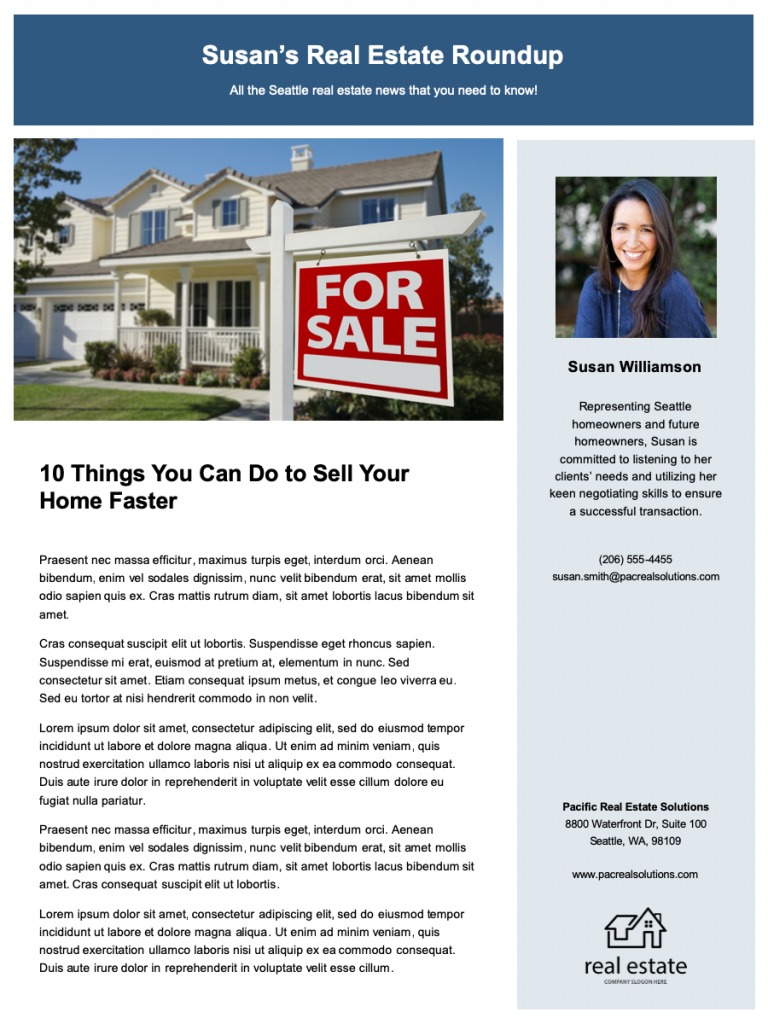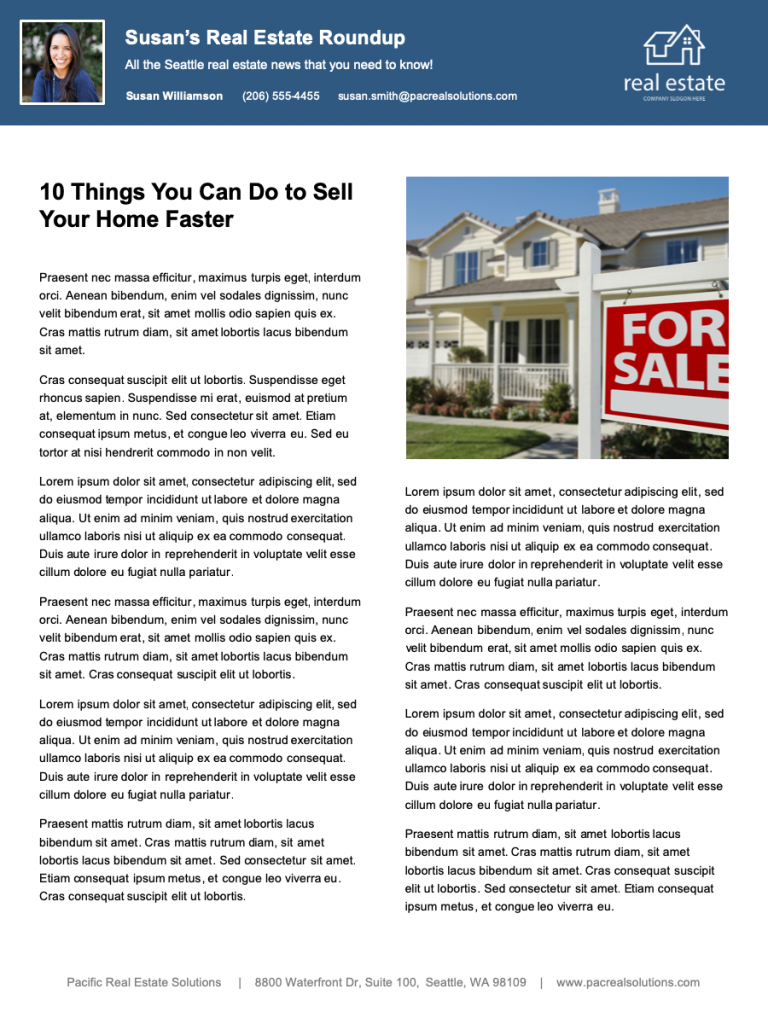Real Estate Newsletter Ideas (Free Templates)
Real estate newsletter ideas for agents, including free real estate newsletter templates and 6 elements of a good email newsletter.

Written by meredithmc on December 10, 2024
In this article:
Outline your real estate newsletter strategy
Create content that meets your audience’s needs
Determine a publication frequency
Monitor performance of your real estate newsletter
6 elements of a good real estate email newsletter
Free real estate newsletter templates
Real estate newsletters, whether print or electronic, can be an effective marketing tool for keeping your name top of mind with your past and current clients, your sphere of influence and your prospects. They reinforce your brand, deliver your message and demonstrate your expertise — all things a successful real estate agent does regularly.
Use the following steps as a guide to help you create your best real estate newsletters for clients and prospects.
Outline your real estate newsletter strategy
Long before you start to design and write a real estate newsletter you should put down on paper why you’re creating one, what its focus will be and how it will be distributed. Setting this strategy will help ensure your campaign is successful.
Define your goals
By defining goals for your real estate agent newsletter, you’ll be able to better determine what type of content you’ll include, what services will resonate with your audience and even what type of template will be most effective. All these factors will contribute to the newsletter’s return on investment, so setting goals is crucial.
Is your real estate newsletter marketing goal to:
- Drive traffic to your website?
- Sell your new listings?
- Establish local expertise for a certain location or type of home?
- Keep yourself top of mind after meeting a potential client?
- Showcase your real estate knowledge to friends and colleagues?
Your goal can be one or more of these options — the important part is having something to measure. And from there, you can see what works and what needs improvement.
Create a marketing plan
Your real estate marketing plan is a long-term commitment that requires organization and a methodical approach. Here’s what you should consider when developing a marketing plan: methodical approach. Here’s what you should consider when developing a marketing plan:
- Make a publishing schedule.
- Plot a year’s worth of content on the calendar.
- Strategize how to build your brand.
- Identify lead sources, including Zillow Premier Agent.
Choose a distribution method
Should you mail your newsletters or deliver them electronically? There’s no universally right or wrong answer — both methods have their pros and cons. “Personally, I’m a fan of getting it out there however you can. Definitely email and social, and printing it will really depend on your budget,” says Bret Calltharp, who trains real estate agents. If you decide to print your newsletter, try to print at a resolution of at least 300 dots per inch (DPI), and make the content easily browsable. Both electronic and print real estate newsletters will:
- Put you in front of selected leads who have shown interest in your product or service
- Keep you in touch with nurtured leads who may not be ready to buy or sell just yet
Electronic newsletters. Most are sent through email, but you could also decide to post them on your website or blog and share them on social media. The downside of emails is that many are deleted before they’re read. Some pros of electronic delivery are:
- It’s easy to edit and customize templates.
- It’s less costly than print (and often free).
- Recipients can easily share your newsletter.
- You can create lists for different areas and include location-specific content.
- You can include videos and links.
- You can create a library of past newsletters on your website.
- You can set up your CRM to automatically send a monthly real estate newsletter.
- You can personalize each email with the recipient’s name.
- You can track performance metrics like open rate, link clicks and engagement if it’s sent through email.
Printed newsletters. While you can track the delivery of your newsletters sent via certified mail, there’s no way to tell how well they are received by your audience. Some pros of printing a real estate newsletter include:
- It may receive more attention than an email.
- It’s a consistent interaction with your audience — it lands in the hands of buyers and sellers.
- It can be distributed to local businesses to reach new clients.
Create content that meets your audience’s needs
Real estate newsletter content should engage your audience, not sell them a product or service. While a well-branded design is important, it’s what’s inside your newsletter that matters most.
“A good newsletter starts with a market update. Don’t just throw stats at people — make sure to show local market knowledge like the best neighborhoods for buyers and sellers, local zoning issues, etc. Then add a home improvement or health tip in a different section.” — Bret Calltharp, real estate agent trainer
Content to include in a real estate newsletter
Bret recommends starting with a personalized market report, one or two good articles, a few spotlight listings and a testimonial if you have one. Here are some real estate newsletter ideas to get you started:
Current market statistics. Include the number of homes listed for sale, the median listing and sale price, and average days on the market. Remember to personalize your newsletter with your take on what the data means. According to Zillow's 2025 Consumer Housing Trends Report for Agents, 75% of sellers consider it important for an agent to be an expert on the local market or have neighborhood knowledge.
Recently sold properties. Buyers and sellers enjoy seeing what has recently sold. Be sure to follow local regulations and your broker’s rules on how to display recent sales and what information to include.
Upcoming activities. Most real estate newsletter articles are targeted to a specific location, so including local activities or events is useful to your readers. Over time, they’ll look forward to receiving your newsletter.
Seasonal tips. Is it tax time? Consider including tips on mortgage deduction (but be careful not to offer tax advice). Is school about to start? Include tips on where to find supplies. Is summer coming up? Create a list of things to do outside.
Home improvement advice. Provide homeowners with projects that will improve resale value. You can even recommend some local contractors.
Neighborhood-specific information. Write an article on the best neighborhoods for buyers or sellers, or which neighborhoods have the best school districts. Forty-four percent of buyers want their agent to help decide if a home is right for them.
Content to avoid in a real estate newsletter
Try to avoid discussions of politics, religion and sensitive current events. While an occasional recipe is OK, don’t let secondary content eclipse your real estate knowledge. Think like a potential buyer, seller or owner — what would you find useful in a newsletter? Focus on including content that the reader can’t get elsewhere.
Determine a publication frequency
Consistency is key to success. Delivering your newsletter at regular intervals builds readership and engagement, as it becomes something your audience looks forward to receiving.
How often should you publish a real estate newsletter?
Bret has had the best return on investment when publishing monthly — “It’s the industry standard,” he says. If you’re just starting out, a quarterly publication may be more effective as you build your brand and figure out what content your audience is looking for. A quarterly schedule gives you more time to create the newsletter content and is frequent enough to establish a regular readership.
When is the best time to send a real estate newsletter?
“Sending your newsletter on Friday gives someone the weekend to look over it,” according to Bret. “A person typically receives less email over the weekend, so it heightens your chances that the email will be read. If you’re doing a market recap, see when your competitors are releasing theirs. I usually suggest shooting for the 10th of the month.”
Monitor performance of your real estate newsletter
It takes time and patience to gain traction, but your newsletter is a powerful marketing tool that supplements your other marketing efforts to bring greater returns. Stick with it and you’ll create a real estate newsletter that not only grows your business but also encourages consumers to engage with it and share with others.
Check deliverables of printed newsletters
For printed and mailed newsletters, you can track deliverability rates through the U.S. Postal Service to ensure your addresses are up to date. This is a great way to minimize printing and postage costs, as you don’t want to send newsletters that don’t reach your intended readers.
Track metrics of your email newsletters
It’s crucial to keep up with your real estate email newsletter once you launch it. Like many marketing efforts, an email newsletter might take some time to generate the results you're working so hard for: readership and contacts. Schedule some time to look at the results — a good idea is to track metrics after three days, one week and one month. Look for:
- Subscribers who opt out
- Subscribers who report the email as spam
- How many people opened your newsletter
- How many people clicked one of your links and which link they clicked
Optimize your real estate newsletter
Regular results are the best way to evaluate your newsletter’s success, so be consistent with your publication frequency. When you see that something isn’t working, think about ways to improve. And when you find a certain type of content that performs well, think about ways to include it in future newsletters. Sometimes poor results can be as simple as a broken link — but other times you’ll have to take a hard look at your content and experiment with ways to change it up.
Reply to comments
As with online reviews, you should always reply to comments. It’s a way to thank your audience for reading your newsletter, and it keeps them engaged. Home buyers and sellers want an agent who’s professional and responsive, so always reply as quickly as possible, include a sufficient answer to their question and consider adding something that encourages them to keep the conversation going.
6 elements of a good real estate email newsletter
Real estate email newsletters provide additional touch points for engaging your audience to help increase your chances of converting a lead. By paying special attention to these elements, you can track what is working and where you may need to make adjustments. Here are six elements of a good real estate email newsletter to help get you started.
1. Compelling subject line
The first thing your audience sees when they receive your real estate email newsletter is the subject line. If it’s not interesting, they will likely discard your newsletter without reading it. A good idea is to test multiple subject lines and use the best performer in the future. Your subject lines should:
- Be short enough to be fully read on mobile, typically 41 characters or 7 words.
- Be personal — use words like “you” or shortcodes to input their first name.
- Offer something unique while accurately reflecting the newsletter’s content.
- Avoid using all caps.
- Use time-sensitive language to create a sense of urgency.
Example: Your [neighborhood] market update is here!
2. Personalization
Personalized emails are a great way to boost engagement. By segmenting your audience by interests or location, you can tailor your real estate newsletters to multiple target audiences. Many email newsletter service providers have this functionality, and it’s easier to do than you might think. Ideas include:
- Information about local events
- A first look at new homes in the area
- Product offerings of interest to buyers and sellers
- A printable coupon for a cup of coffee at a local cafe or a discount at a local store
Based on response rates, you can change your future newsletters to include more of the content your audience engages with. As a Zillow Premier Agent, you can use the Premier Agent App to assign a status to your leads. Then you’ll easily be able to develop a follow-up plan for each lead type and set reminders to ensure you stay on plan.
3. Clear call to action (CTA)
Clearly display your contact information and branding on every newsletter. This information should include:
- Your logo
- Your name, email, phone number and business address
- Your website and social media handles
- Your real estate license number
- A professional photo of yourself

4. Tools for engagement
Gaining rapport with your audience only happens when both of you participate in the conversation. Your content must invite readers to contribute and share. Encourage engagement by including:
- A quick poll
- An opinion or testimonial section at the end
- A button that links to your website’s comments section
- A way for the reader to share the newsletter with friends, family and colleagues
5. Receivable
Different browsers and devices display emails differently. Send yourself a couple test emails and open them in multiple browsers, as well as on your phone and a tablet if you have one. It’s also a good idea to test multiple email platforms. Outlook and Gmail are the most common.
6. Include options for opting out
The CAN-SPAM Act is a set of requirements for sending emails. It gives recipients the right to opt out of your emails and establishes penalties for violations like:
- Using false or misleading header information
- Using deceptive subject lines
- Including an advertisement in article form without telling readers it’s an ad
- Not telling recipients where you’re located
- Not including instructions on how to opt out of your emails
- Not honoring requests to opt out of your emails
Contact a lawyer for more information on the CAN-SPAM Act and its requirements.
Free real estate newsletter templates
Make sure the design of your newsletter, from the layout to the images and colors and fonts, is consistent with your other branded material. You want people to easily connect your newsletter, website, flyers and signage. With our real estate newsletter templates, you’ll be able to:
- Choose a layout that fits your brand’s style.
- Adjust the color and font.
- Click in a field to add your logo, photos, content and contact information.
- Add clear images to engage your audience (at least 300 DPI).
Template for established homeowners
This real estate newsletter template design allows for a featured article as the main point of engagement. Good options for a featured article include local market updates and seasonal home improvement tips.

Market uses. Use this free real estate newsletter template for homeowners who have been in their current home for a while. By featuring market updates or home improvement tips in the main article and in a section on recently sold homes, homeowners will be more aware of their property’s value and how to improve it when they decide to sell.
Download our established homeowners newsletter template
Template for new homeowners
This real estate newsletter template has a short feature article, and it’s a great place to focus on neighborhood news like a new coffee shop, park improvements, etc. You also have a place to answer questions from your clients.

Market uses. This template is a good idea for new homeowners or anyone who may not be ready to sell just yet. It allows for two short pieces of content — one in article form and one as a Q&A. The Q&A section allows you to show off your knowledge of the neighborhood, the market and your general skills as a real estate agent.
Download our new homeowners newsletter template
Template for a wide range of audiences
If you want to focus more on content and less on recently sold homes, this is the real estate newsletter template to use. It has room for an article, local events and a short secondary article at the bottom.

Market uses. It can be a good idea to use this template when you’re sending a newsletter to a wide range of audiences or when you’re printing them out and leaving them with local businesses. With room for two articles and a neighborhood events section, this template will appeal to a wide range of homeowners as well as future home buyers.
Tips for top-performing listings
Backed by new research, this guide reveals what today’s top listings do differently to capture buyer attention and outperform the rest.
Learn more

